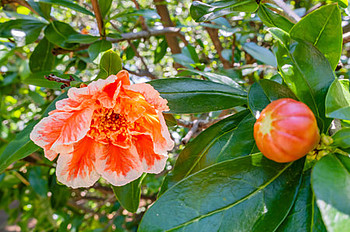Origin of the pomegranate
Botanically speaking, the pomegranate is a berry, even though outwardly it is not so different from our apples. The name pomegranate - Punica granatum in technical language - is a partial takeover of the Latin name of the fruit "malum granatum" which means apple with seeds. The pomegranate probably originates from the Mediterranean region, as a subtropical to tropical climate is ideal for the fruit.
The pomegranate in mythology and the Bible
The history of the pomegranate goes back a long way: archaeological finds show that the pomegranate fruit was already consumed in the Bronze Age. The fruit already had an important meaning in the past: because in addition to being a grave offering, the pomegranate has also been used as a symbol in mythological stories, in the Bible and in pictures over the last millennia. The round fruit with the shimmering seeds inside has impressed people for a long time.
Preferred climate: the pomegranate likes it warm

Originally from the Mediterranean region, the pomegranate tree likes it warm. But now there are also varieties that grow in cooler climates. So you can also plant certain pomegranate varieties in Germany in typical wine-growing areas. The flowers of the pomegranate tree grow to five to six centimetres in size, are intensely orange in colour and open in June to September, depending on the climate.
The pomegranate: cultivation and harvest
Most of the fruits that we find in supermarkets in Germany come from the region of Turkey, Iran, Georgia and India all the way to China. This is because the pomegranate grows and ripens best in the warm climates that prevail there. But there are also other areas where pomegranates are grown: Nowadays, there are also plantations in the USA and South America. The harvest takes place between September and December. It is important that the fruit should only be harvested when it is fully ripe. Unlike other fruits, the pomegranate does not ripen after picking. Once the fruit is ripe, it can be picked from the tree. The fruit has a diameter of up to ten centimetres and has many walls inside. The chambers contain the flesh in the form of edible, angular seeds surrounded by a glassy, juicy seed coat.
Pressing of the fresh fruit in the country of cultivation
Pomegranates do not ripen. But when they are harvested ripe, they can dry out if they are stored too long. This can be recognised by the fact that the fruit loses its round shape and becomes angular, because the skin contracts as it dries out. To ensure that only ripe and fresh pomegranates are used for our Rabenhorst pure juice from first pressing, the fruits are pressed for us purely in the country of origin. This preserves as many of the natural ingredients in our Pomegranate juice as possible.
How you can use the pomegranate
You can use pomegranates either fresh, as juice or as an ingredient in delicious recipes. Because of its fresh sweet and sour taste, the pomegranate is often used for, among other things:
- Desserts and sweets
- Jellies
- A sauce for meat
- Salads
- Lemonades and drinks
FAQ
How can you eat pomegranates?
There are several ways in which a pomegranate can be eaten. On the one hand, the seeds can be eaten fresh after they have been carefully separated from the fruit. On the other hand, pomegranates can also be eaten in the form of juice, pureed or boiled down into a jelly - the sweet and sour taste remains.
Can you eat the skin of the pomegranate?
No, the skin and the inner partitions of the pomegranate are bitter and inedible. Only the small red seeds inside the fruit are edible. You can tell whether the pomegranate seeds are already ripe by looking at the skin: if it has the richest possible red hue, the seeds are ripe.

